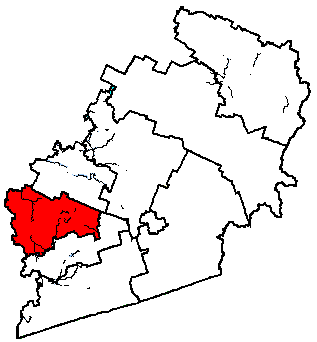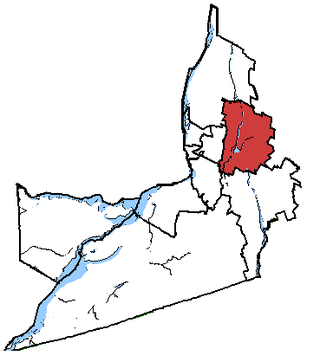
Saint-Hyacinthe—Bagot is a federal electoral district that has been represented in the House of Commons of Canada since 1935. It is located in Quebec, Canada. Its population in 2006 was 95,983. In the 2015 election, the winner received the lowest vote percentage of any winning candidate in the country.

Saint-Bruno—Saint-Hubert was a federal electoral district in Quebec, Canada, that was represented in the House of Commons of Canada from 1988 to 2015. Its population in 2001 was 99,755.

Bécancour—Nicolet—Saurel is a federal electoral district in Quebec, Canada, that has been represented in the House of Commons of Canada since 1968.
Richelieu was a federal electoral district in Quebec, Canada, that was represented in the House of Commons of Canada from 1867 to 1935.

Chambly—Borduas was a federal electoral district in the province of Quebec, Canada, that was represented in the House of Commons of Canada from 1867 to 1935, and from 1968 to 2015. Created by the British North America Act of 1867, its name was changed in 1893 to "Chambly—Verchères". In 1933, it was amalgamated into the Chambly—Rouville and Richelieu—Verchères electoral districts. The district was re-created in 1966 from Chambly—Rouville, Châteauguay—Huntingdon—Laprairie, and Richelieu—Verchères. Its name was changed in 2003 to "Chambly—Borduas". In 2015, most of the district became part of Beloeil—Chambly, while small parts of it joined Montarville and Pierre-Boucher—Les Patriotes—Verchères.

Verchères—Les Patriotes was a federal electoral district in Quebec, Canada, that was represented in the House of Commons of Canada from 1979 until the 2012 electoral redistribution.
Yamaska was a federal electoral district in Quebec, Canada that was represented in the House of Commons of Canada from 1867 to 1935.
St. Hyacinthe—Rouville was a federal electoral district in Quebec, Canada, that was represented in the House of Commons of Canada from 1917 to 1935.
Chambly—Rouville was a federal electoral district in Quebec, Canada, that was represented in the House of Commons of Canada from 1935 to 1968.
Verchères was a federal electoral district in Quebec, Canada, that was represented in the House of Commons of Canada from 1867 to 1892, and from 1988 to 1997.
Verchères is a provincial riding in the Montérégie region of Quebec, Canada. It corresponds exactly to the territory of Marguerite-D'Youville Regional County Municipality.
Bernard Pierre Loiselle was a Liberal party member of the House of Commons of Canada. He was a lawyer by career.
Verchères was an electoral district of the Legislative Assembly of the Parliament of the Province of Canada, in Canada East, primarily south of Montreal. It was created in 1841, based on the previous electoral district of the same name for the Legislative Assembly of Lower Canada.
Verchères could refer to:
This page is based on this
Wikipedia article Text is available under the
CC BY-SA 4.0 license; additional terms may apply.
Images, videos and audio are available under their respective licenses.


